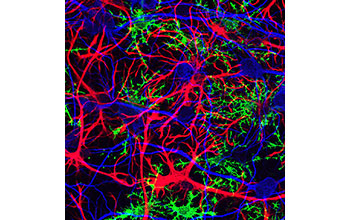Multimedia Gallery
Astrocytes are the most abundant cells in the human brain
In this image, star-shaped glia cells called astrocytes (red) are the most abundant cells in the human brain. Young oligodendrocytes (green) are glia that help insulate nerve cell axons. The blue cells are neurons. Recent research suggests that glia play a vital role in brain cell communication and perhaps in the development of human intelligence.
[The U.S. National Science Foundation supported a workshop in 2013 (grant SMA 1258562) which enabled researchers who study learning and memory to get together (many for the first time) and reconsider the function of glia.]
Learn more in the NSF Discovery story The beautiful brain cells you don't know about. (Date of Image: unknown) (Date added to Multimedia Gallery: Sept. 30, 2014)
Credit: Jonathan Cohen, National Institutes of Health
Images and other media in the National Science Foundation Multimedia Gallery are available for use in print and electronic material by NSF employees, members of the media, university staff, teachers and the general public. All media in the gallery are intended for personal, educational and nonprofit/non-commercial use only.
Images credited to the National Science Foundation, a federal agency, are in the public domain. The images were created by employees of the United States Government as part of their official duties or prepared by contractors as "works for hire" for NSF. You may freely use NSF-credited images and, at your discretion, credit NSF with a "Courtesy: National Science Foundation" notation.
Additional information about general usage can be found in Conditions.
Also Available:
Download the high-resolution TIF version of the image. (3.1 MB)
Use your mouse to right-click (Mac users may need to Ctrl-click) the link above and choose the option that will save the file or target to your computer.

 All images in this series
All images in this series